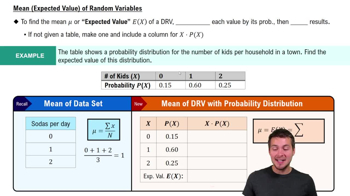Is the mean found in the preceding exercise a statistic or a parameter?
Table of contents
- 1. Intro to Stats and Collecting Data1h 14m
- 2. Describing Data with Tables and Graphs1h 55m
- 3. Describing Data Numerically2h 5m
- 4. Probability2h 16m
- 5. Binomial Distribution & Discrete Random Variables3h 6m
- 6. Normal Distribution and Continuous Random Variables2h 11m
- 7. Sampling Distributions & Confidence Intervals: Mean3h 23m
- Sampling Distribution of the Sample Mean and Central Limit Theorem19m
- Distribution of Sample Mean - Excel23m
- Introduction to Confidence Intervals15m
- Confidence Intervals for Population Mean1h 18m
- Determining the Minimum Sample Size Required12m
- Finding Probabilities and T Critical Values - Excel28m
- Confidence Intervals for Population Means - Excel25m
- 8. Sampling Distributions & Confidence Intervals: Proportion1h 12m
- 9. Hypothesis Testing for One Sample3h 29m
- 10. Hypothesis Testing for Two Samples4h 50m
- Two Proportions1h 13m
- Two Proportions Hypothesis Test - Excel28m
- Two Means - Unknown, Unequal Variance1h 3m
- Two Means - Unknown Variances Hypothesis Test - Excel12m
- Two Means - Unknown, Equal Variance15m
- Two Means - Unknown, Equal Variances Hypothesis Test - Excel9m
- Two Means - Known Variance12m
- Two Means - Sigma Known Hypothesis Test - Excel21m
- Two Means - Matched Pairs (Dependent Samples)42m
- Matched Pairs Hypothesis Test - Excel12m
- 11. Correlation1h 6m
- 12. Regression1h 50m
- 13. Chi-Square Tests & Goodness of Fit1h 57m
- 14. ANOVA1h 57m
5. Binomial Distribution & Discrete Random Variables
Discrete Random Variables
Problem 5.3.9a
Textbook Question
In Exercises 9–16, use the Poisson distribution to find the indicated probabilities.
Births In a recent year (365 days), NYU-Langone Medical Center had 5942 births.
a. Find the mean number of births per day.
 Verified step by step guidance
Verified step by step guidance1
Step 1: Understand the Poisson distribution. The Poisson distribution is used to model the number of events (e.g., births) occurring in a fixed interval of time or space, given the events occur independently and at a constant average rate.
Step 2: Identify the total number of events and the time interval. In this problem, there are 5942 births over 365 days.
Step 3: Calculate the mean number of births per day. The mean (λ) for a Poisson distribution is the total number of events divided by the total time interval. Use the formula: .
Step 4: Simplify the fraction to find the mean number of births per day. This value represents the average rate of births per day at the medical center.
Step 5: Use this mean (λ) for further calculations if needed, such as finding probabilities of specific numbers of births per day using the Poisson probability formula.
 Verified video answer for a similar problem:
Verified video answer for a similar problem:This video solution was recommended by our tutors as helpful for the problem above
Video duration:
1mPlay a video:
Was this helpful?
Key Concepts
Here are the essential concepts you must grasp in order to answer the question correctly.
Poisson Distribution
The Poisson distribution is a probability distribution that expresses the probability of a given number of events occurring in a fixed interval of time or space, given that these events occur with a known constant mean rate and independently of the time since the last event. It is particularly useful for modeling rare events, such as the number of births in a day.
Recommended video:
Guided course

Intro to Frequency Distributions
Mean of a Poisson Distribution
In a Poisson distribution, the mean (λ) represents the average number of occurrences of the event in the specified interval. For the problem at hand, to find the mean number of births per day, you would divide the total number of births by the number of days in the year, providing a clear understanding of the expected daily occurrences.
Recommended video:
Guided course

Mean & Standard Deviation of Binomial Distribution
Expected Value
The expected value is a key concept in probability that provides a measure of the center of a probability distribution. In the context of the Poisson distribution, the expected value is equal to the mean (λ), which indicates the average outcome one can anticipate over a specified period. This concept helps in making predictions about future occurrences based on historical data.
Recommended video:
Guided course

Expected Value (Mean) of Random Variables

 7:09m
7:09mWatch next
Master Intro to Random Variables & Probability Distributions with a bite sized video explanation from Patrick
Start learningRelated Videos
Related Practice
Textbook Question
